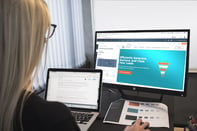Published on
E-Portfolios Raise the Bar for Adult Learners

E-portfolios allow students to demonstrate to potential employers what they’ve learned both in and out of a classroom.
These methods can be transformational not only for traditional students but for adult learners who may have more to put in their portfolio than they think.
The EvoLLLution (Evo): What does an institution’s use of e-portfolios benefit adult learners?
Nicholas Vaught (NV): Adult learners come with a wealth of experience gained outside of the traditional classroom—years of professional experience, community involvement, religious involvement and even family life. For our traditional-age students, we naturally think about e-portfolios as a good way to capture all the extracurriculars in which they are involved. They may intern for a couple of semesters, and an e-portfolio allows them to articulate the learning that occurred within it and relate it and integrate it with their coursework. For adults, it really raises the bar. Their professional experience runs deeper and can lead to profound insights about how the real world has shaped their worldview.
An e-portfolio gives adults the space and time to reflect on what they’ve experienced through their career. The challenge with adult learners is assisting them in connecting that vast experience with concrete course concepts, ideas and artifacts from courses. So, an e-portfolio is a natural tool for this integrative learning because you can hyperlink, upload attachments and multimedia, because craft an ongoing narrative. Students, especially adult students, are able to bring together their entire world and no longer have a separation between academic and professional lives.
When assessing experiential learning, we need a space for adults to talk at length and to really explore and deeply reflect on their professional experiences, and an e-portfolio allows that reflection to occur. The unlimited space and profound introspection enable the instructor or assessment team to decipher the depth of learning that occurred outside the classroom and the depth of integration with actual academic concepts and ideas and theories. For our interdisciplinary studies programs at Morgan, we use a modified version of the AAC&U’s VALUE Rubrics on integrative learning and problem solving to assess students’ ability to integrate curricular and co-curricular learning and apply it to a new scenario. Using these rubrics pushes the students to think deeply about the connections between their coursework and their real-world experience. It also challenges the instructors to push students toward deeper understandings of their learning from both within and beyond the classroom. Every semester we hear from students that they didn’t realize how much real-world applicability their courses had until they had been given space and time to reflect on it.
Evo: Once students have an e-portfolio, how do they demonstrate what they’ve learned to employers?
NV: Students create their e-portfolio using a number of website creation tools and can take that portfolio with them after graduation. We structure our e-portfolio into two distinct sections. The first section is insights, which is what the student has learned in their curricular and co-curricular experiences and the integration between those two. And the second section is problem solving—looking at a distinct and complex problem within the student’s field and utilizing those insights to solve the problem. We challenge students to consider how they will use the learning they’ve acquired and apply it to a complex issue or problem in their field.
Ultimately, this reflective process follows Kolb’s cycle of learning, with students really reflecting on their professional experience or their community service as well as their classroom learning. Students then move into the abstract conceptualization phase and say, “I’ve had this experience, and here’s what I’ve learned from it.” Then they move into applying that learning to a new and complex setting, then reflecting on that again and continuing on through the cycle.
This becomes a really interesting tool for employers because it doesn’t just communicate what the student has learned inside the classroom. If you’re getting a college graduate, you know if they have X major or Y major, you sort of know what that means, but this is a tool that really demonstrates the holistic learning acquired throughout the students collegiate and professional experience and how they can apply it in a field they’re passionate about.
That’s really compelling for an employer and can speak to them much more than your typical resume or cover letter can because it really dives into the depth of student learning. Students can take the URL from their portfolio and put it on their resume, their cover letter or on their LinkedIn. Through my years of working on e-portfolios, I’ve noticed that students often take it after the course and enhance it for their own use. It becomes truly a professional portfolio. It’s always exciting to go back and look at links from old semesters and see, “Hey, these students have really taken this as the tool that they’re using in their life.”
Evo: What types of problems have students been able to solve and demonstrate to employers?
NV: I just had a student this past semester who worked in communications and media for years and years and came back to finish her degree. And she started to pick up on bias in hiring practices within her sector of the media and how after a few folks are passed over, then it becomes a trend. So, what do you do to raise up that next generation, especially other folks of color? She really demonstrated how her insights applied to that, mentoring the next generation and being an advocate for the future media professionals
Evo: After finishing their e-portfolio, do students tend to work in the same industry or do they make a career switch?
NV: From my experience, many students don’t transition into a new field when they’re adult learners. I think it qualifies them for promotions within the field they’re in, or they move into a slightly peripheral field. I’ve had students go from being correctional officers to working in law enforcement—that’s more of a parallel move. Other folks have been para-educators and are able to become teachers. So, it really just enables them to continue in the career they’re already in.
Many students will, once they earn their degree in any of the interdisciplinary studies majors, go on to graduate school. That’s been really exciting to see. There’s not really a limit for what they can do. The limit is really based on how they’ve designed their program and the experiences they’ve already had as professionals.
Evo: Where institutions can expand e-portfolios in the future?
NV: At Morgan, many programs are now moving to having capstone courses or senior seminars. So, there are really no longer exams, like your senior comprehensive exam or anything like that. And large programmatic assessment of student learning can be provided through e-portfolios. Because e-portfolios are holistic in nature and can combine the curricular and the co-curricular, sometimes the learning is surprising. We thought that students were learning X in our courses, and instead they’re learning Y. We know what’s really sticking with them, and that’s only knowledge you get when you have really in-depth reflective experiences for students.
This is useful not only in interdisciplinary studies and your traditional humanities but also in STEM. It would be fantastic if programs across higher education adopted e-portfolios to really capture the totality of the student experience because our STEM students are doing amazing things, having amazing internships, conducting novel undergraduate research. And while those can be fantastic lines on resumes, there’s much deeper knowledge that occurs that we can really capture and assess in an e-portfolio. One thing we know about e-portfolios is that they’re high-impact practices. So, when a student is working on their e-portfolio, especially throughout their academic career and not just at the tail end, it leads to greater persistence, higher GPAs, better graduation rates. If we can implement e-portfolios on a broader scale, not just at Morgan but across higher education, it will benefit students. Even if the student doesn’t save the e-portfolio, and it becomes an artifact in time, that practice of reflection and deep thinking is invaluable for the student to construct meaning around their academic and co-curricular experiences.
Evo: How was Morgan able to increase the number of enrolled adult students in the last five years?
NV: One way is by creating flexible degree programs. Many times, programs meant for adult students are retrofits of existing programs. But when you build from the ground up, programs provide more flexibility for students in what their course sequence looks like, how we use past credits, the number of credits we use. Students can transfer 90 credits—that’s three quarters of their degree. Just providing students with the flexibility of degree programs has been instrumental in increasing adult enrollment at Morgan State. Within the Applied Liberal Studies program, we’ve also seen a large increase each year of adult learners returning to school, typically bringing 70 to 90 credits with them. These students often are former Morgan students, but more and more are transfer students.
And through the Applied Liberal Studies program and College of Interdisciplinary and Continuing Studies, we’ve provided a more flexible framework for students to earn their degrees in high-demand areas. That’s led to an increase in enrollment but more than that—persistence to graduation. It’s one thing to bring in adult students. It’s another to help them get across that finish line. We have advisors trained in and passionate about working specifically with adult students. And we keep the advising caseload pretty low for advisors, which allows them to check in on students repeatedly throughout the semester to ask about academics, kids, family, jobs to really support the whole student.
Adult learners can sometimes have the propensity of stopping out again, so this proactive outreach has led to an increase in retention of adult learners. It’s also led to increased persistence among adult learners, getting them to not just re-enroll but walk across the stage at graduation. Then word gets out! When someone goes back to school, and they’re finally able to get that degree after 10, 15, 40 years, they tell their friends and family.
With the new College of Interdisciplinary and Continuing Studies, we’re growing on the success of the Applied Liberal Studies program to attract even more adults to Morgan State, especially adult learners who may not be aware of our institution and who could transfer in a large amount of credits and finish up their degree with us. We’ve implemented several systems to do that, from low tuition rates, to advising support, a flexible course schedule and course availability.
This interview was edited for length and clarity.
Author Perspective: Administrator



